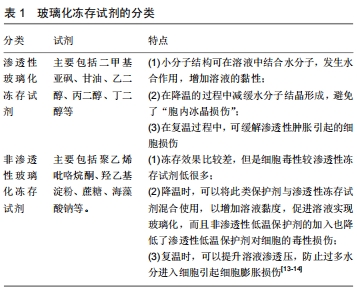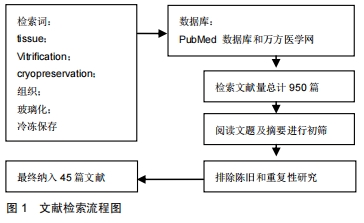[1]李建国,李盼,尹合勇,等.五种玻璃化冻存试剂单独或组合应用对髓核细胞的毒性分析[J].中国组织工程研究, 2016,20(11):1570-1576.
[2]SOLANKI PK,RABIN Y.Analysis of polarized-light effects in glass-promoting solutions with applications to cryopreservation and organ banking. PloS one.2018;13(6): e0199155.
[3]窦蒙家,张明宽,饶伟,等.人体低温保存——通向未来“永生”之路[J].科学(上海),2017,69(6):1-4.
[4]FINGER EB, BISCHOF JC. Cryopreservation by vitrification: a promising approach for transplant organ banking.Curr Opin Organ Transplant.2018;23(3):353-360.
[5]刘威,郭明伟,郭治宇,等.胞内冰形成机理研究进展[J].制冷学报, 2018, 39(3):126-134.
[6]邱佳裔,贾晓青,黄岗,等.细胞,组织冻存方法及应用的研究进展[J].中国生物制品学杂志,2017,30(5):546-550.
[7]袁海涵,马玉珍.玻璃化冻存卵巢的研究进展[J].世界最新医学信息文摘(电子版), 2016(81):12-13.
[8]ONOFRE J, FAES K, KADAM P, et al. What is the best protocol to cryopreserve immature mouse testicular cell suspensions.Reprod Biomed Online. 2018;37(1):6-17.
[9]TAJIMI H, YAMAZAKI T, OIKE S, et al. Vitrification for bovine embryos with low-quality grade.Anim Sci J. 2018;89(8):1194-1200.
[10]HOSSEINI A, KHALILI MA, TALEBI AR, et al. Cryopreservation of Low Number of Human Spermatozoa; Which is Better: Vapor Phase or Direct Submerging in Liquid Nitrogen.Hum Fertil (Camb). 2019;22(2): 126-132.
[11]DONNEZ J, GARCIA-SOLARES J, DOLMANS MM. Fertility preservation in women with ovarian endometriosis. Clin Med Insights Reprod Health. 2019;13:1179558119873386.
[12]秦廷武,莫湘涛,杨志明.生物活性产品玻璃化冷冻保存研究进展[J].生物医学工程学杂志,2005,22(5):1070-1074.
[13]KILBRIDE P, MORRIS GJ. Viscosities encountered during the cryopreservation of dimethyl sulphoxide systems.Cryobiology. 2017; 76:92-97.
[14]SULTANI AB, MARQUEZ-CURTIS LA, ELLIOTT JA, et al. Improved Cryopreservation of Human Umbilical Vein Endothelial Cells:A Systematic Approach.Sci Rep.2016;6: 34393.
[15]曾玉翠,吴瑞芳.卵巢组织冻存方案的优化研究进展[J].国际生殖健康/计划生育杂志,2015, 34(2):141-144.
[16]EHRLICH LE, FAHY GM, WOWK BG, et al. Thermal Analyses of a Human Kidney and a Rabbit Kidney During Cryopreservation by Vitrification.J Biomech Eng. 2018;140(1).
[17]WOWK B, FAHY GM, AHMEDYAR S, et al. Vitrification tendency and stability of DP6-based vitrification solutions for complex tissue cryopreservation.Cryobiology. 2018;82:70-77.
[18]MOHSENZADEH M, SALEHI-ABARGOUEI A, TABIBNEJAD N, et al. Effect of vitrification on human oocyte maturation rate during in vitro maturation procedure:A systematic review and meta-analysis. Cryobiology. 2018;83:84-89.
[19]杨云,周新丽,周楠峰,等.卵母细胞冷冻保存技术新进展[J].生殖与避孕, 2015,35(3):179-184.
[20]CHAPUT L, GREMEAU AS, VORILHON S, et al. Fertility preservation in oncology.Bull Cancer.2018; 105(1):99-110.
[21]FISCH B, ABIR R. Female fertility preservation: past, present and future.Reproduction. 2018;156(1):F11-F27.
[22]DONNEZ J, DOLMANS MM. The ovary: from conception to death. Fertil Steril.2017;108(4):594-595.
[23]SILBER S. Ovarian tissue cryopreservation and transplantation: scientific implications.J Assist Reprod Genet. 2016;33(12):1595-1603.
[24]DONNEZ J, DOLMANS MM, PELLICER A, et al. Restoration of ovarian activity and pregnancy after transplantation of cryopreserved ovarian tissue: a review of 60 cases of reimplantation.Fertil Steril 2013;99(6):1503-1513.
[25]KONG HS, KIM EJ, YOUM HW, et al. Improvement in Ovarian Tissue Quality with Supplementation of Antifreeze Protein during Warming of Vitrified Mouse Ovarian Tissue. Yonsei Med J.2018; 59(2):331-336.
[26]NATEGHI R, ALIZADEH A, JAFARI AHANGARI Y, et al: Ethylene Glycol and Dimethyl Sulfoxide Combination Reduces Cryoinjuries and Apoptotic Gene Expression in Vitrified Laying Hen Ovary.Biopreserv Biobank. 2017;15(6): 519-528.
[27]BRITO DC, DOMINGUES SFS, RODRIGUES APR, et al. Vitrification of domestic cat (Felis catus) ovarian tissue: Effects of three different sugars.Cryobiology. 2018;83:97-99.
[28]MEULI M, MEULI-SIMMEN C, FLAKE AW, et al. Premiere use of Integra artificial skin to close an extensive fetal skin defect during open in utero repair of myelomeningocele. Pediatr Surg Int.2013; 29(12): 1321-1326.
[29]IBRAHIM SM, KAREEM OH, SAFFANAH KM, et al. Histological and mechanical evaluation of antifreeze peptide (Afp1m) cryopreserved skin grafts post transplantation in a rat model.Cryobiology.2018; 82: 27-36.
[30]WILSON TC, WILSON JA, CRIM B, et al. The Use of Cryopreserved Human Skin Allograft for the Treatment of Wounds With Exposed Muscle, Tendon, and Bone.Wounds. 2016;28(4):119-125.
[31]HOLZER PW, LEONARD DA, SHANMUGARAJAH K, et al: A Comparative Examination of the Clinical Outcome and Histological Appearance of Cryopreserved and Fresh Split-Thickness Skin Grafts.J Burn Care Res. 2017;38(1): e55-e61.
[32]WOOD JM, SOLDIN M, SHAW TJ, et al. The biomechanical and histological sequelae of common skin banking methods.J Biomech. 2014;47(5):1215-1219.
[33]NAALDIJK Y, JOHNSON AA, FRIEDRICH-STOCKIGT A, et al. Cryopreservation of dermal fibroblasts and keratinocytes in hydroxyethyl starch-based cryoprotectants.BMC Biotechnol. 2016; 16(1):85.
[34]CORYDON C, HJORTDAL J, EHLERS N. Re-examination of organ-cultured, cryopreserved human corneal grafts after 27 years.Acta Ophthalmol.2009;87(2):173-175.
[35]BOURNE WM, NELSON LR. Human corneal studies with a vitrification solution containing dimethyl sulfoxide, formamide, and 1,2-propanediol. Cryobiology.1994;31(6):522-530.
[36]BOURNE WM, SHEARER DR, NELSON LR. Human corneal endothelial tolerance to glycerol, dimethylsulfoxide, 1,2-propanediol, and 2,3-butanediol. Cryobiology. 1994;31(1): 1-9.
[37]KITO K, KAGAMI H, KOBAYASHI C, et al. Effects of cryopreservation on histology and viability of cultured corneal epithelial cell sheets in rabbit.Cornea.2005;24(6):735-741.
[38]CAIXEIRO NJ, BYUN HL, DESCALLAR J, et al. Health professionals' opinions on supporting a cancer biobank: identification of barriers to combat biobanking pitfalls.Eur J Hum Genet.2016;24(5):626-632.
[39]张源,杨秋蕊,张洪丹,等.新型玻璃化冻存技术在活肿瘤组织样本库建设中的应用[J].中国组织工程研究,2018,22(4):587-592.
[40]ZENG M, YANG QR, FU GB, et al. Maintaining viability and characteristics of cholangiocarcinoma tissue by vitrification-based cryopreservation. Cryobiology. 2017;78:41-46.
[41]KAHN D, LES C, XIA Y. Effects of cryopreservation on the depth-dependent elastic modulus in articular cartilage and implications for osteochondral grafting.J Biomech Eng. 2015; 137(5):054502.
[42]Jomha NM, Elliott JAW, Law GK, et al. Vitrification of intact human articular cartilage. Biomaterials. 2012;33(26): 6061-6068.
[43]VANGSNESS CT JR, HIGGS G, HOFFMAN JK, et al. Implantation of a Novel Cryopreserved Viable Osteochondral Allograft for Articular Cartilage Repair in the Knee.J Knee Surg. 2018;31(6):528-535.
[44]NAQVI SM, GANSAU J, BUCKLEY CT. Priming and cryopreservation of microencapsulated marrow stromal cells as a strategy for intervertebral disc regeneration.Biomed Mater.2018;13(3):034106.
[45]RAJAGOPAL K, CHILBULE SK, MADHURI V. Viability, proliferation and phenotype maintenance in cryopreserved human iliac apophyseal chondrocytes.Cell Tissue Bank. 2014;15(1):153-163.
|



